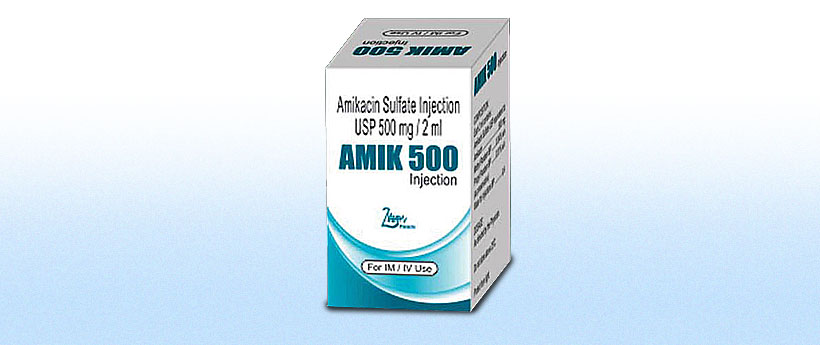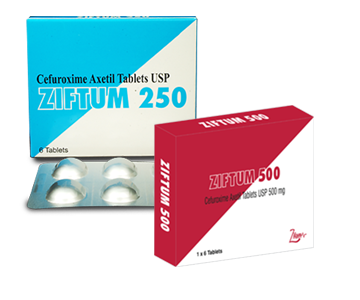Amik 500
- ENG
- မြန်မာ

Composition:
Each 2ml contains:
Amikacin Sulfate USP equivalent to
Amikacin. ….500mg
Methyl Paraben BP……….0.04% w/v
(as preservative)
Propyl Paraben BP………….0.01%w/v
(as preservative)
Water for Injection USP……….q.s.
Description: Amikacin Sulfate Injection is an aminoglycoside antibiotic, which is active against a broad spectrum of Gram-negative organisms, including pseudomonas and some Gram-positive organisms.
Pharmacokinetics: Amikacin is rapidly absorbed after intramuscular injection. Twenty per cent or less is bound to serum protein. In adults with normal renal function the plasma elimination half-life of amikacin is usually 2-3 hours.
Indications:
Serious Bacterial Infections
Amikacin sulfate injection is indicated in the short-term treatment of serious infections due to susceptible strains of Gram-negative bacteria, including Acinetobacter, Escherichia coli, Enterobacter, Klebsiella, Proteus, Providencia, Pseudomonas, or
Serratia marcescens. Amikacin may be the preferred
aminoglycoside for initial treatment of serious nosocomial gram-negative infections, especially in areas where resistance to gentamicin and tobramycin has been reported.
Although amikacin and other aminoglycosides are not usually recommended for the treatment of staphylococcal infections however, amikacin may be considered for the treatment of known or suspected staphylococcal infections in certain situations. This includes initial treatment of severe infections when the causative organisms may be either gram-negative bacteria or staphylococci, treatment of infections caused by susceptible staphylococci in patients hypersensitive to other more appropriate anti-infectives, and treatment of mixed infections that may involve both gram-negative bacteria and staphylococci.
Intra-abdominal Infections:
Amikacin is used for the treatment of serious intra-abdominal infections (including peritonitis) caused by susceptible gram-negative bacteria, including Acinetobacter, Enterobacter, E. coli, Klebsiella, Proteus, Providencia, Serratia, or Pseudomonas. Amikacin usually is used as an adjunct to other appropriate anti-infectives (e.g., clindamycin, metronidazole, piperacillin and tazobactam, ampicillin and sulbactam).
Meningitis and Other CNS Infections
Amikacin is used for the treatment of meningitis caused by susceptible gram-negative bacteria. Like other aminoglycosides, amikacin should not be used alone for the treatment of meningitis, but may be used in conjunction with other anti-infectives.
Amikacin has been used in conjunction with ampicillin for initial empiric treatment of meningitis caused by Streptococcus agalactiae (group B streptococci) in neonates or for Listeria monocytogenes meningitis in children. Concomitant use of amikacin and a third-generation cephalosporin also has been used for the treatment of neonatal gram-negative bacterial meningitis, including infections caused by E. coli. In adults, amikacin has been used concomitantly with impenem for the treatment of meningitis caused by E. coli, concomitantly with meropenem for the treatment of meningitis caused by Pseudomonas, or concomitantly with impenem or colistin (commercially available as colistimethate sodium) for the treatment of meningitis caused by Acinetobacter.
Mycobacterial Infections
Amikacin is used in conjunction with antituberculosis agents for the treatment of active tuberculosis.
Amikacin is considered a second-line agent for use in multiple-drug regimens in patients with relapse, treatment failure, or Mycobacterium tuberculosis resistant to isoniazid and/or rifampin or when first-line drugs cannot be tolerated. Streptomycin-resistant M. tuberculosis may be susceptible to both amikacin and kanamycin; complete cross-resistance usually occurs between amikacin and kanamycin. Patients with treatment failure or drug-resistant M. tuberculosis should be managed in consultation with an expertin the treatment of tuberculosis.
Other Mycobacterial Infections
Amikacin has been used as an alternative agent in multiple-drug regimens used for the treatment of M. avium complex (MAC) infections. A regimen of amikacin, ethambutol, rifampin, and ciprofoxacin and a regimen of amikacin, ethambutol, ciprofloxacin, and clarithromycin or azithromycin has been used with some success in HIV-infected patients.
Amikacin is used in conjunction with other antimycobacterial anti-infectives for the treatment of non-pulmonary infections caused by M. abscessus, M. chelonae, and M. fortuitum.
Nocardia Infections
Amikacin is used in the treatment of infections caused by Nocardia. Sulfonamides (usually co-trimoxazole) are the treatment of choice for most Nocardia infections; concomitant use of amikacin, imipenem, and/or ceftriaxone is recommended for initial treatment of severe or disseminated infections. When sulfonamides cannot be used, some clinicians recommend regimens containing amikacin, a carbapenem (imipenem or meropenem), a third-generation cephalosporin (ceftriaxone), a tetracycline (doxycycline, minocycline), fixed combination of amoxicillin and clavulanate, clarithromycin, cycloserine, or linezolid can be used.
Empiric Therapy in Febrile Neutropenic Patient
Amikacin is used for empiric anti-infective therapy of presumed bacterial infections in febrile neutropenic patients. Amikacin is used in conjunction with an appropriate antipseudomonal cephalosporin (e.g., ceftazidime, ceftriaxone, cefepime), extended-spectrum penicillin (e.g., piperacillin and tazobactam, ticarcillin and clavulanate), or carbapenem (e.g., imipenem, meropenem).
Pulse Therapy
Amikacin and Dapsone is used for the treatment of actinomycotic foot.
Amikacin demonstrates synergetic action with carbenicylin, benzylpenicillin and cephalosporins (co-administration with beta-lactams may decrease in aminoglycoside efficacy in patients with severe chronic renal impairment).
It is used also in infections of bile-excreting tracts, infections of bones and joints (including. osteomyelitis), wound infection and post-operative infections.
Dosage Administration
For proper dosage patient’s weight should be known. The dosage is same for intravenous and intramuscular injection.
Adults and children: 15 mg/kg/day in two equally divided doses.
Neonates and premature infants: An initial loading dose of 10 mg/kg followed by 15 mg/kg/day in two equally divided doses.
Use in pregnancy and lactation
Amikacin is excreted into human milk in small amounts. Due to poor oral bioavailability, systemic toxicity in the nursing infant is unlikely, it is recommended that if nursing mothers must be given amikacin, the infants should not be breastfed during therapy.
Aminoglycosides cross the placenta and there is a potential risk of fetal nephrotoxicity and ototoxicity.
Contraindications
High sensitiveness to amikacin and aminoglycoside antibiotics. Pregnancy and uremia.
Adverse Reactions
All aminoglycosides have the potential to induce auditory vestibular and renal toxicity and neuromuscular blockage. Toxic effects on the 8th cranial nerve can result in hearing loss or balance, or both. Amikacin primarily affect auditory function. Cochlear damage includes high frequency deatness and usually occurs before clinical hearing loss can be detected. Acute muscular paralysis and apnea can occur following treatment with aminoglycoside drugs.
Drug Interactions
Drugs with nephrotoxic potential (eg, bacitracin, cisplatin, amphotericin B, colistin, vancomycin, enflurane, methoxyflurane). May increase risk of nephrotoxicity.
Loop diuretics (eg, furosemide). May increase risk of auditory toxicity.
Neuromuscular blocking agents (eg, tubocurarine). Amikacin may enhance effects of these agents.
Overdosage
In the event of dosage or toxic reaction, peritoneal dialysis or haemodialysis will aid in the removal of amikacin from the blood,
Storage
Do not store above 30°C. Protect from light,
Presentation
Each Box of 1 vial.
Updated on 9/Feb/2024







